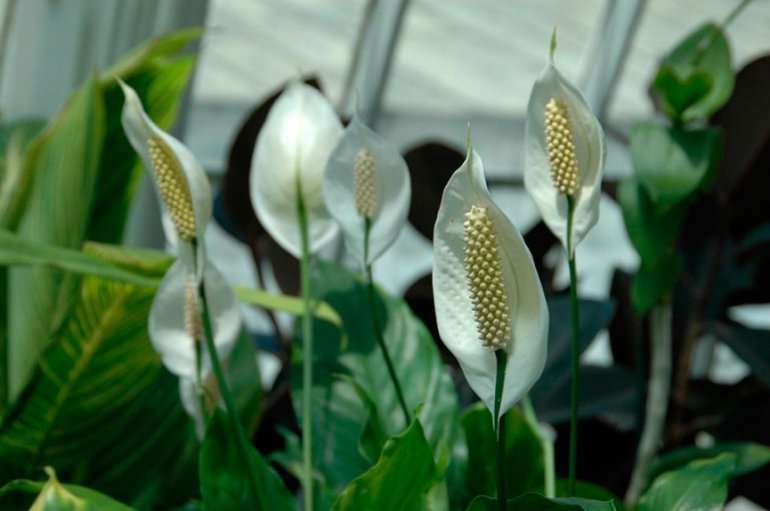Watering methods
In order to prevent further problems with the cultivation of spathiphyllum, it is recommended to make sure that the earthen coma is dry before irrigation. For these purposes, a wooden skewer is often used, which is placed in the soil substrate.
Irrigation is carried out carefully, leading the watering can along the edge of the flowerpot. During the procedure, the leaves and flowers must remain dry, without water droplets. If the green mass gets wet, wipe off excess moisture with a napkin.
The spray should be thin when watering to maintain the integrity of the soil layer. Also, do not constantly pour water at one point, otherwise a hole will soon form in this place.
When keeping a flower at home, Women's happiness must be properly organized and not disturbed by the irrigation system, otherwise the risk of various diseases increases. Especially, the soil moisture in the pot should be controlled after transplanting a tropical plant.
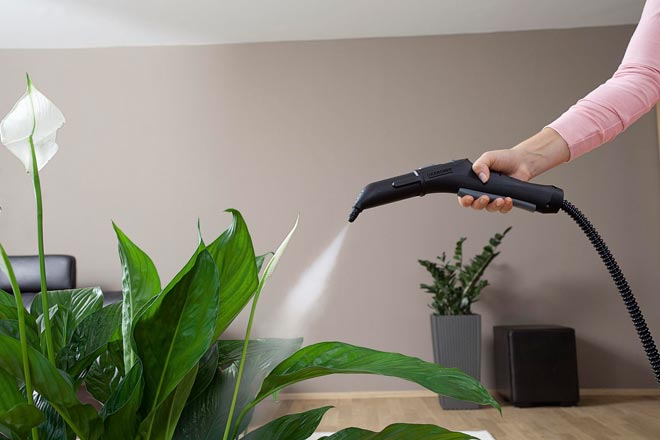
Plant diseases
Pests do not always provoke diseases. Illiterate care can lead to the loss of the external attractiveness of the bush and its further death. We have prepared for you the most common houseplant holder mistakes that you should not make.
Lack of flowering
This problem signals that it is necessary to apply fertilizer to the soil in the near future. You can also increase the humidity in the room and check if a transplant is needed. Spathiphyllum will delight with regular and abundant flowering only if it grows in a cramped pot. It is necessary for the root system to fill all the available space.
Yellow leaves
Lack of light or occasional watering can lead to a loss of green color. You may want to look for a sunnier spot in your home for the plant and moisturize the soil more often. Remember: in the period after flowering, yellowing of the leaves is considered a normal biological process that does not require external intervention.
Blackening of the leaves
Spathiphyllum is a plant that reacts to excessive soil moisture, the result of which is the appearance of black spots on the lateral leaves. It may also be due to frequent feeding. This problem can be dealt with by adding a foundationol solution to the soil (dosage - 2 grams of substance per 1 liter of water).
Drying of the tips of the leaves
A symptom may indicate too dry indoor air. A special device - a humidifier and frequent spraying of leaves with water from a sprayer - will help you cope with this problem.
Greening flowers
If you notice that after the appearance of new flowers in spathiphyllum, greening of old ones is observed, do not panic. This is a natural behavior of plants, as the fading bedspreads of the petals gradually acquire a green tint.
Now you know everything about how to care for the flower of female happiness, which is sometimes called a lady's. Follow our simple tips and be sure - you will definitely succeed! Do not forget: the plant perfectly tolerates the neighborhood with other crops, so it can be grown in mixed plantings.
Some flower growers create unusual compositions on the windowsills, displaying spathiphyllum next to it and, for example, Andre's anthurium, which is often called “male happiness”. Their red and white flowers are perfectly combined, they look very original and unusual. Good luck!

The unusual shape of the inflorescence arouses incorruptible interest in the spathiphyllum plant. This flower can turn even the most unsightly room into a cozy place.At the same time, the plant is not capricious in its care, but it has its own nuances.
They relate to irrigation, for each crop a certain need for moisture is important. The vital processes of the spathiphyllum directly depend on the quality of hydration.
You can find out about this and other important factors of care for this beautiful plant in this article.
Why doesn't spathiphyllum bloom?
If spathiphyllum receives the wrong care, it will not bloom. There may be several reasons:
- the pot where the plant is planted is too voluminous, until it is filled with roots, there will be no flowering;
- low ambient temperature, insufficient humidity;
- the plant is starving, has not been transplanted and fertilized for a long time;
- the plant is old or sick.
Blackening, drying out or yellow leaves will become signs of trouble for the plant. In this case, it is necessary to find problems and eliminate them without bringing the plants to death.
So, if the leaf petioles rot, then this is stem rot when the ground is wet and cold. The plant needs to be transplanted into another pot, removing the decaying parts and sprinkling the cut with crushed coal.
If a lot of leaves turn yellow, then waterlogging is possible, but if there is no rotting, this is a sign of lack of nutrition or excessive lighting. If only the lower leaves are yellow, you need to adjust the watering. However, if the plant is close to the battery in winter, the leaves may also dry out.
Blackening leaves signal both underfilling and overflow. Perhaps the earth lacks phosphorus and nitrogen. If the tips of the leaves dry up, this indicates dry air, or the plant has not yet taken root after transplantation. These colors can be prescribed a weekly shower in the bathroom.
Features of watering a flower Women's happiness at different times of the year
Spathiphyllum came to us from tropical countries, where the level of air humidity is extremely high, therefore, watering should be appropriate, but in no case should the substrate be flooded.
- During the growing season (spring - summer), the plant should be watered once every 1 - 2 days, gradually increasing the amount of moisture with the onset of summer. Depends on the room temperature. When it rises, more water is consumed, and when it goes down, less.
- When spathiphyllum begins a dormant period (autumn - winter), the amount of water for irrigation should be reduced, because the plant needs less moisture at this time, and its excess will be detrimental to the vulnerable flower. How many times a week should you water during this time? You can water about 2 - 3 times a week and reduce the amount of water closer to winter (is it possible to transplant spathiphyllum in winter and how to properly care for the plant?).
- In spring and summer, the plant must be sprayed daily, thereby maintaining a comfortable moisture regime for it, in winter, spraying is reduced to 3-4 times a week. It will also help to remove dust from the lush leaves of the spathiphyllum.
When watering spathiphyllum, first of all, you need to look not at the timing, but at the dryness of the upper layer of the substrate in the pot. If it is dry enough, then it is urgent to water the flower. If it is a little wet, then watering is definitely not needed.
Read about other intricacies of caring for spathiphyllum in this material.
The importance of feeding for "female happiness"

Competent feeding is the key to the health and longevity of spathiphyllum. In this case, it is necessary to strictly observe the dosage, frequency, and also choose the right product. In addition, the application time is of great importance. At the initial stage (immediately after planting), spathiphyllum does not require fertilizers, everything it needs is provided by the soil. But over time, the soil is depleted, and the flower begins to "starve". The reason is the limited space of the pot, and, accordingly, the feeding area. That is why top dressing is of great importance.
Otherwise, decorativeness will be lost, the plant will become weak, and the color of the foliage will become dull, growth and development will stop, flowering stops. Over time, such a flower dies.
How to care for a flower female happiness in a pot
Women's happiness is a flower, caring for which at home usually does not cause problems. It is not difficult to provide him with comfort (a sufficient level of air humidity, regular watering, lighting and fertilizing). Surround him with love and care, then the spathiphyllum will delight with its beauty and frequent flowering.
Lighting
Although the plant loves well-lit places, burns may appear on the surface of its leaves under the influence of direct ultraviolet rays. Therefore, the ideal option would be to place the pot on the windowsill on the south side of the apartment. This will extend the flowering period and make the bush look larger. Remember: in summer it is necessary to shade the plant.
Watering
Spathiphyllum is a tropical inhabitant, so it is important to provide a comfortable indoor humidity level. During flowering in spring and summer, abundant watering is required (every three days), but waterlogging of the soil is unacceptable
An abundance of moisture can lead to the appearance of spots on the leaves, signaling the beginning of rotting of the plant's root system. In winter, it is necessary to carry out the procedure less often and protect the flower from drafts.
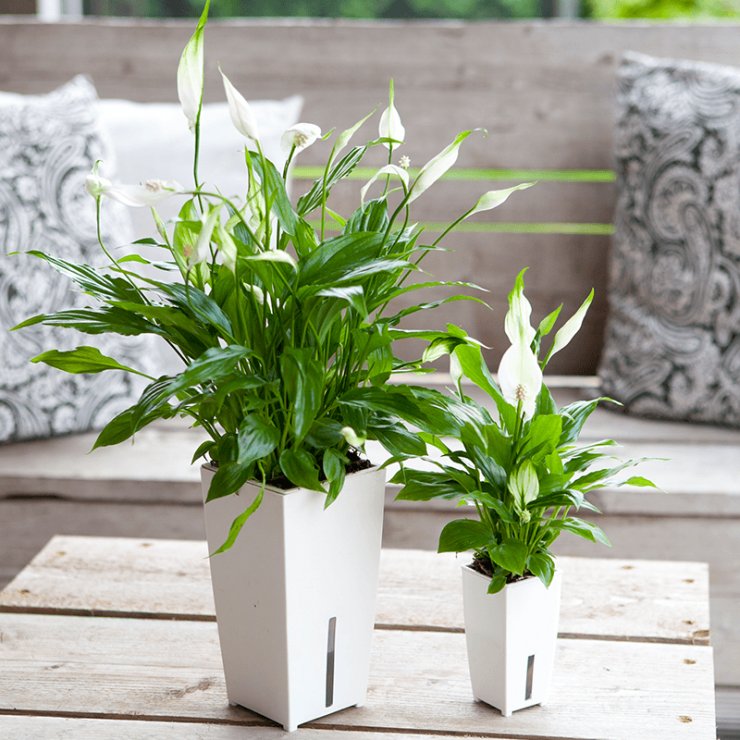
Air humidity
It is important to constantly maintain high humidity in the room where the plant lives (more than 80%). Regular spraying of leaves from a spray bottle, as well as a warm shower in the summer will only be beneficial.
It is sometimes recommended to place the spathiphyllum in a special tray with wet moss, sand and water, or place it near the aquarium. So you can create comfortable conditions for the growth and development of the plant due to the gradual evaporation of moisture.
During the period when women's happiness begins to bloom, the spraying procedure should be extremely careful so that drops of water do not fall on the buds. Do not forget to periodically wipe the casting of spathiphyllum with a damp sponge or cloth to remove accumulated dust and dirt from their surface.
Optimal room temperature
Spathiphyllum loves warmth. For the normal development of the plant, it is necessary to ensure a temperature of at least 22 ° C. It should be noted that the flower does not tolerate sharp fluctuations very well, therefore it must be constantly maintained at an optimal level.
Soil composition
The ideal soil for spathiphyllum is slightly acidic. You can buy the substrate from a garden store or prepare it yourself. To do this, you need to mix peat and humus, add a little river sand and unsifted sheet mixture. Do not forget to provide the plant with a drainage layer by laying expanded clay or charcoal on the bottom of the pot.
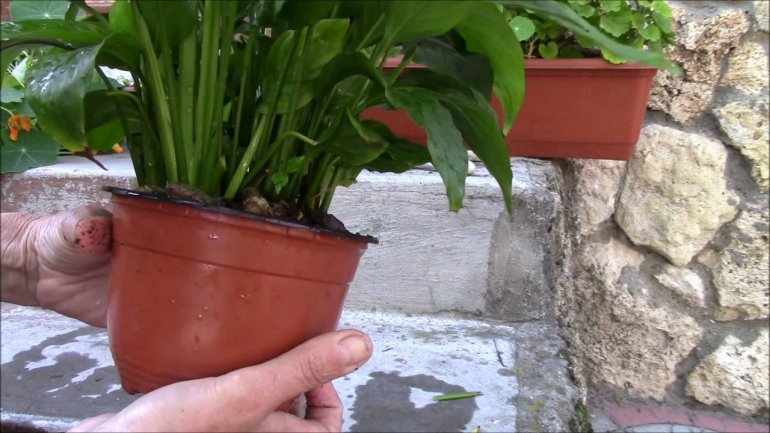
Top dressing
The key to the good development of female happiness is its timely feeding. This will give him strength for full growth and development, and will also help him bloom as soon as possible. Fertilize the plant at least once every 2 weeks.
You can use specialized formulations for aroid crops or prepare a nutrient mixture yourself (from chicken droppings, mullein). Avoid using fertilizers that contain nitrogen. This compound promotes the growth of the green mass of the plant and can inhibit the process of budding and flowering.
From the beginning of spring to the end of the summer season, the plant requires mineral supplements to shorten the time it takes to recover from the state of winter dormancy. Dry mixtures are dissolved in a small dosage - 1 g per 100 ml of water. The soil is preliminarily watered abundantly to protect the root system from burns.
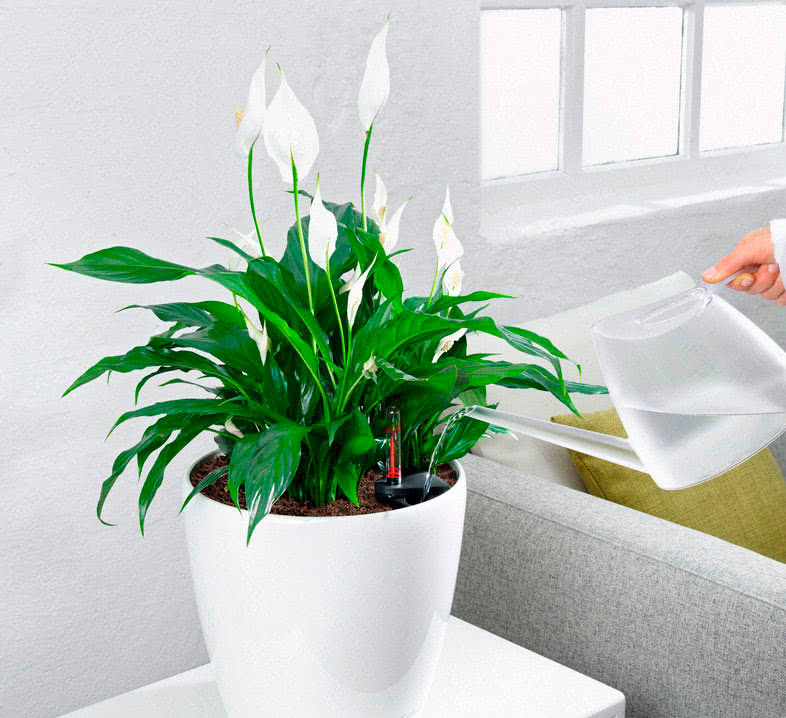
Signs of a lack of nutrition
In spathiphyllum, like any other plant, nutritional deficiencies are expressed in external changes.
Magnesium deficiency leads to stunted growth, external lethargy of the flower.
The leaves begin to gradually turn yellow or brown, but the veins retain their green color. These plants need feeding with magnesium sulfate.
From an excess of fertilizer, the leaves begin to dry at the edges, and multiple black spots appear in the middle.
This is how the root system of the plant burns from overfeeding with nutrients. In the future, the leaves dry out completely and fall off. An immediate transplant with the obligatory rhizome washing will help to save the plant.
If the leaves turn yellow, the leaves begin to wither after abundant flowering, the plant needs complex feeding - it has expended all its energy on this process.
Liquid specialized fertilizers for aroids or transplanting into a larger pot with new nutrient soil will help to solve the problem.
If the foliage turns yellow, and the veins remain green, this may also indicate iron chlorosis. Other options for uneven yellowing are usually reduced to calcium and boron deficiency.
To solve the problem, spraying spathiphyllum with iron chelate (if iron chlorosis was detected) or preparations containing boron and calcium will help.
Small and pale leaves indicate plant starvation.
It is necessary to apply a complex fertilizer to solve the problem.
Deficiency of phosphorus, potassium can be expressed in the absence of flowering (against the background of a general healthy state).
Fertilization with nitrogen-containing agents should be limited, replacing them with potassium and phosphorus-containing ones.
How to propagate by cuttings?
The method of propagation of anthurium by cuttings is very popular. Its essence lies in the rooting of a small part of the shoot, cut from the green part of the plant. Cuttings can be carried out in three ways: leaf, apical and air-rooted. In the first case, a leaf acts as a cutting, in the second, the tip of an adult shoot, and in the third, a cutting with aerial roots. It is worth considering these methods in more detail.
Sheet
Almost all types of anthurium can be propagated by the sheet method, while spending a minimum of time and effort. For propagation of a flower by leaf cuttings, a strong leaf is cut from an adult healthy plant, which has clearly pronounced veins. In this case, the length of the petiole should be from 3 to 5 cm. The leaf is tied into a vertical tube and placed with the petiole in a pre-moistened mixture of sand and peat, taken in equal parts. Above the surface of the ground, usually 1/3 of the sheet is left, which is then covered with a jar.
A man-made greenhouse is placed in a warm and well-lit place, while trying to prevent direct ultraviolet rays from entering, which through the glass of the jar can cause a burn of the cutting. It is necessary to ventilate and irrigate the plant and soil daily, and continue this until a young sprout appears from the inside of the leaf tube. This will mean that rooting was successful and the plant can be transferred to a general care regimen. To do this, the jar is removed, and the shoot is transplanted into a permanent container with pre-prepared soil.
As an alternative to the substrate, root growth can be carried out in water. To do this, the leaf is placed in water at room temperature with a root growth stimulant diluted in it, while no more than 4–5 cm of the leaf should be immersed in the liquid.
Airborne
Cuttings with aerial roots are one of the most effective propagation methods. It consists of the following:
- a strong shoot with several internodes and two leaves is cut from an adult healthy plant, after which the leaves are cut off, leaving only the petioles; this is done so that the forces of the young shoot go not to feed the green mass, but exclusively to build up the root system;
- then the cutting is planted in a sandy-peat substrate so that only air roots are in the ground, and the growth point remains above the surface;
- further, the plant is irrigated with a spray bottle and covered with a bag;
- the greenhouse is transferred to a bright, warm place, not forgetting to spray and air the escape every day; it is advisable to sprinkle with slightly warmed water so that the plant steamed in the greenhouse does not experience stress from temperature extremes.
The sprout takes root very quickly. A new leaf should appear in a maximum of a week. After its appearance, the package is removed, the plant is transplanted to a permanent place and transferred to a general care regimen.
Apical
Apical cuttings propagation is also a popular method and consists of the following:
- using a sharp knife, cut off the top of the shoot and leave it for 15 minutes to dry the cut; the stalk should be exactly 12 cm long and have 2 healthy leaves;
- the shoot is placed in perlite and removed to a warm and bright place with a temperature of at least +24 degrees;
- spraying is carried out daily.
The first roots usually appear after 3 weeks. After their regrowth up to 3 cm, the plant is transplanted to a permanent place.
Important! Whichever method of reproduction is carried out, the cut sites on the mother must be disinfected. For more information on the reproduction of anthurium by apical cuttings, see the next video
For more information on the reproduction of anthurium by apical cuttings, see the next video.
Selection rules
Spathiphyllum chopin - description of a home flower
When planting a large spathiphyllum bush or transferring a purchased plant into a new container, pay attention to the choice of a pot and soil recommended for indoor culture
Pot
When choosing which pot is needed for spathiphyllum, the size of the previous one is determined. The plant is planted in a container, which exceeds the former container by 1.5-2 cm in width and height. Florists noticed that spathiphyllum blooms profusely when the roots cover the entire substrate.
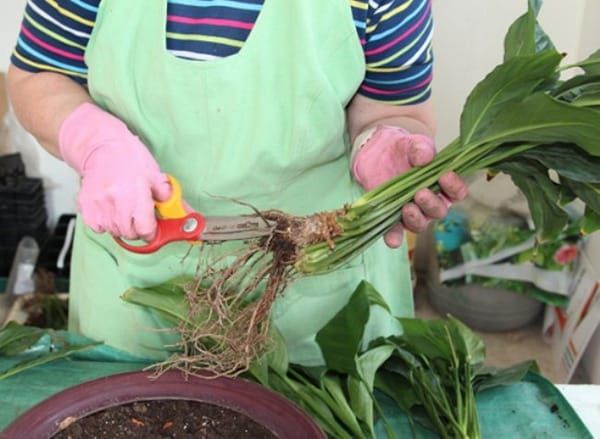
Pruning
In a pot that is too spacious, the bush will grow the root system and only then discard the peduncles. Containers with holes in the bottom are suitable, through which excess water flows into the pan after watering. As with any indoor plant, a drainage of 1-2 cm is required for spathiphyllum.
Soil
Spathiphyllum develops well in a weakly acidic substrate, pH 5-6.5, loose and light in structure. In such potting mixes, excess moisture seeps into the sump. In the trade network, they choose a universal mixture for aroid or tropical flowering plants, which is mixed with a handful of sand. Many growers prepare the substrate on their own. You can choose a suitable one, usually the simplest in execution, from several options:
- 3 parts of peat, 2 parts of leafy soil, 1 part each of humus, sand and bone meal;
- 1 part of leafy soil, peat, humus, sand, 2 parts of sod land;
- 1 part of leafy soil and peat, half of soddy soil and sand.
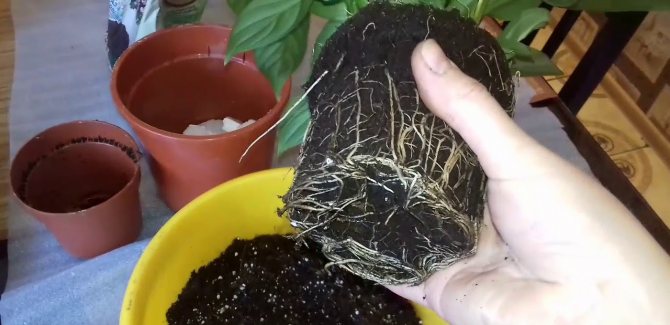
Pot
Horse peat is used. Wood bark, coconut fiber, charcoal and brick chips are also added to the substrate for looseness. Additives make up no more than 10% of the total mass. They also put sphagnum moss, which protects the soil mixture from drying out.
When transplanting, fertilizer is added - 0.5 teaspoon of superphosphate. If the substrate is prepared independently, the earth is spilled with a dark pink hot solution of potassium permanganate.
Fertilizers
For good flowering, spathiphyllum is regularly maintained with top dressing, otherwise a beautiful green bush will grow, but without the original white covers with flower cobs. Or the stalks will be thrown out for a short time and at long intervals.
It is especially important to feed the plant in the spring-summer period, when all processes are activated: once every 10-16 days
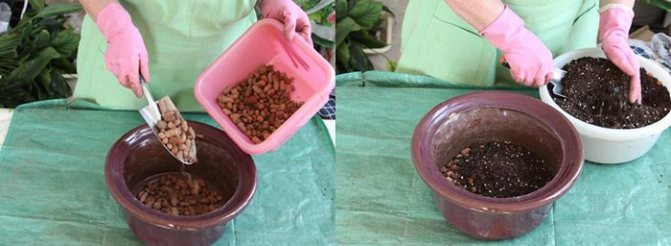
Priming
In winter, when the dormant period begins in the room culture, the substrate is fertilized once every 30 days. Spathiphyllum responds well to organic fertilizers available in stores, especially poultry droppings. Any universal preparations for flowering indoor plants are also suitable: "Flower", "Azalea" and others.
If no fertilization was applied at the end of February or in March, the spathiphyllum ends blooming in June, and the flower stalks do not form again. At the same time, too many nitrogen preparations should not be given, since the green mass will grow, but not the buds.
Note! Florists noticed that the appearance of brown spots on the leaf blades is evidence of an excess of nutrients. Housewives often pour the "female happiness" with chilled liquid after boiling pasta or potatoes, used from the aquarium with water
In late autumn and winter periods, when the intensity of natural lighting decreases, the humic fertilizer "Universal plant balm" is used for spathiphyllum. The drug stimulates culture and helps to cope with the lack of light
Housewives often pour the "female happiness" with chilled liquid after boiling pasta or potatoes, used from the aquarium with water. In late autumn and winter periods, when the intensity of natural lighting decreases, the humic fertilizer "Universal plant balm" is used for spathiphyllum. The drug stimulates culture and helps to cope with the lack of light.
How often should you water?
The main thing is to observe 2 most important and prerequisites for the healthy growth of spathiphyllum: a certain frequency of watering and timely spraying. Under natural conditions, spathiphyllum grows in the shade under trees and closer to water bodies. Therefore, it is easy to conclude that for the healthy growth of this flower, it is necessary to create conditions that are as close to natural as possible. This means that year-round high humidity is very important. This requires spathiphyllum to be sprayed at least once a week throughout the year.
In some apartments, where the air is particularly dry, you can keep the plant in a tray with pebbles and water, or install a humidifier next door. It is necessary to spray the flower actively in winter, when heating batteries work at full capacity in our apartments.
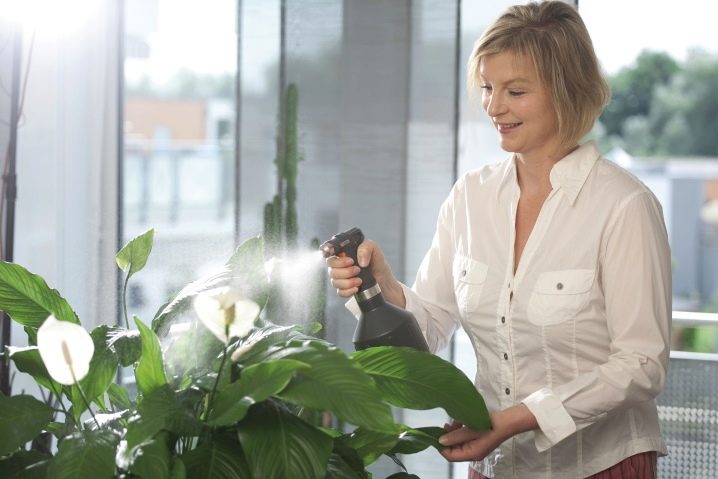
Only one thing can be said for sure about the frequency of watering - at least once a week in winter, or even better twice, it is imperative to thoroughly shed the "female happiness". In summer, the frequency of watering can be up to 1 time in 3 days.
Of course, it is important to adhere to these recommendations, but do not overdo it so as not to flood the flower. Wait until the top layer of the earth is dry
How often to water spathiphyllum is a rather individual question. In each case, the conditions will be different. All experienced flower growers claim that you can and should look closely at any plant and adapt to watering. How to determine that it is definitely time to water the flower, we will tell you below.
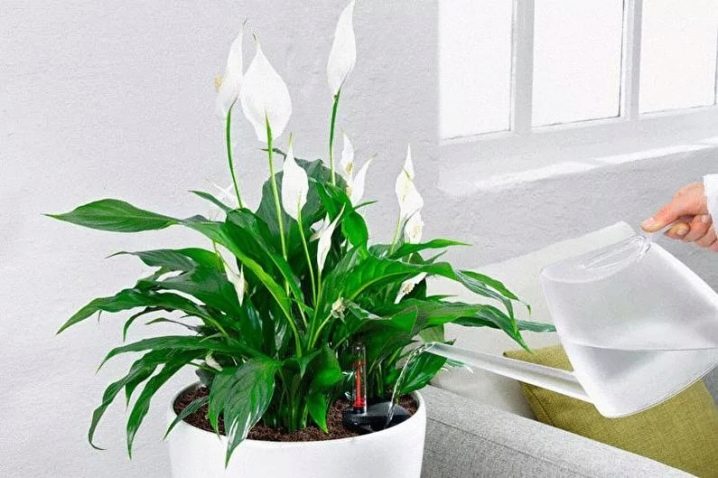
Diseases arising from improper watering
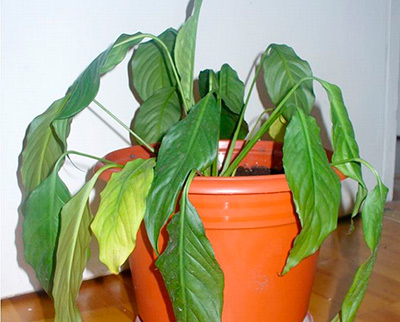 When watering a plant, you should always carefully examine the leaves. They are the indicators of the health of the flower. The appearance of diseases is promoted not only by improper watering, but also by parasites. Most often these are:
When watering a plant, you should always carefully examine the leaves. They are the indicators of the health of the flower. The appearance of diseases is promoted not only by improper watering, but also by parasites. Most often these are:
- Shield aphid (or scale insect) - usually located on the back of the leaf and on the stems. It feeds on the sap of the plant, which first leads to dark spots, then completely to the drying out and death of the leaf.
- Mealybug - most often appears if the flower is flooded with water. A humid environment is ideal for this pest. You need to look for it between the leaves and on the stems.
- Spider mite - this pest can be considered the most unpleasant and dangerous. It sucks the juice from the plant, entangling the leaves with a small whitish cobweb.
- Sooty mushroom - spreads on the surface of the leaf in the form of dark spots. Under these spots, the plant can neither breathe nor grow.
Post-transplant care
At first, or rather about two to three weeks, spathiphyllum is in dire need of high humidity. For those who do not want to wait long for the plant to bloom again or bother with special care, then here's a piece of advice: move the pot with "Women's Happiness" to a greenhouse or something similar. Similarity means, for example, a plastic bag. Under the so-called "hood" a greenhouse effect is formed and the plant feels very good.
The only thing that you will need in the future is to take out the spathiphyllum for airing. If you go a long way and do not use a mini-greenhouse, then keep an eye on the humidity level. If it is in short supply, the flower will begin to turn yellow and wither. Then it is required to spray up to three times a day, watering only when the soil dries up (about 5-10 mm).
There are some simple steps to follow to speed up survival and prevent disease.
Air humidity
The plant needs to provide sufficient air importance. Observing this condition, you can achieve the appearance of beautiful leaves without spots.
It is important to spray spathiphyllum daily with water from a sprayer. In the summer, the number of spraying is increased. You can increase the humidity by placing a jar filled with water next to the plant.
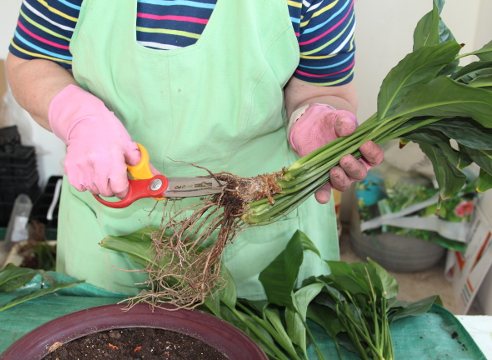
Watering a flower
Balanced watering is required. With insufficient moisture, the leaves turn yellow. If the leaves have dropped down, they look lethargic and lifeless, then this is also a signal of a lack of water. Moisture must be present in the roots of the flower. Watering must be carried out when the top layer of the earth in the pot dries out.
For irrigation, it is advisable to use filtered water at room temperature. It is recommended to add 5 drops of vinegar 9% to 1 liter of water, the flower loves acidified water.
If the plant has dropped its leaves, this indicates an excess of moisture. In winter, watering spathiphyllum is reduced, removed away from heating appliances. It should be remembered that you cannot overmoisten the soil. The roots should not be in the water, this will lead to decay. After each watering, excess water is poured out of the pan.
When to feed
The transplanted plant is fed with fertilizers starting from 5-6 weeks after transplanting. Fertilizers are applied during the growing season (spring and summer) once a week. The rest of the time, the flower is fed once a month. For top dressing, fertilizers containing nitrogen and a small amount of potassium are used. It is necessary to strictly follow the instructions for breeding the fertilizer, since an overdose can lead to undesirable consequences, then to death.
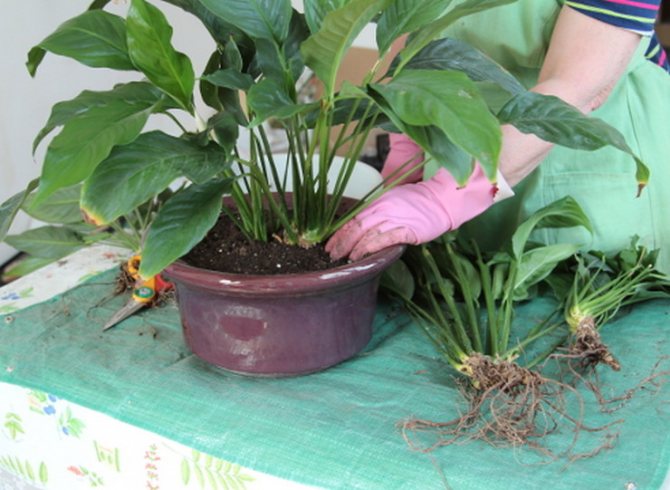
Frequently asked questions
Why doesn't spathiphyllum grow?
First of all, it should not be excessively flooded with moisture and placed in a brightly lit place. If these conditions are met, then the flower was placed in a pot that was too wide during transplantation.
The plant threw all its strength into strengthening and expanding the root system, and therefore, it no longer had enough strength to grow. Transplant the plant into a narrow pot with a little cramped roots.
Why does a newly acquired healthy flower start to slowly turn yellow and dry?
It is important to remember that flowers bought in a store must be transplanted into a previously purchased soil mixture, or prepared by yourself. Bring the flower home, carefully remove it from the pot along with the earthy clod and shake off the "store" soil as much as possible
More about caring for women's happiness
Cover the pot with pebbles or expanded clay, new soil and plant a flower. Do not be alarmed if it turns yellow a little - it must adapt to the new environment.
How to prepare the soil for spathiphyllum at home?
If you don't have a ready-made substrate, make one yourself. Mix equal proportions of sand, peat and soil humus.Add some bark and charcoal to these. Pour the sod over the mixture and mix.
Important! Do not forget that there should be pebbles or expanded clay at the bottom of the pot. They help to get rid of excess moisture and prevent root rot
What if the white spathiphyllum flower turns green?
To eliminate this problem, you can carefully cut off old flower stalks at the base of the stem with a sharp blade or knife, being careful not to hurt adjacent stems. Powder the cut with crushed charcoal.
If the flowers continue to remain green, then there is a possibility that this type of spathiphyllum was acquired. One should not think that the “veil” of a flower is only snow-white. The color ranges from white to beige and light green. More about the flowering of spathiphyllium.
How often to water
Since the Feminine Happiness flower belongs to tropical crops, moist soil and an increased level of humidity in the room are needed for its normal growth and development. But, as in everything, one should observe the measure here. There should be no stagnation of liquid in the pot, otherwise the root mass will begin to rot and the flower will die. Alternatively, you can install a pallet with wet sand, moss near the flowerpot.
The need to irrigate the soil in the pot will be signaled by a completely dried earthy clod and drooping leaves of the flower. Despite the moisture-loving nature of a tropical plant, in order not to harm it, you should adhere to simple recommendations:
In addition to regular procedures, spathiphyllum should be sprayed from a spray bottle once a week or its leaves should be wiped with a damp sponge. When choosing the intensity and abundance of watering, you should focus on the seasons
Particular attention should be paid to the state of the flower culture, it often gives signals itself in the form of lowering the corners of the leaf plates
Diseases of spathiphyllum
Insect pests
Sometimes spathiphyllum is disturbed by aphids and spider mites. You can fight these pests by wiping the leaves of the plant with a soapy solution with the addition of nicotine sulfate. Before processing, cover the soil in the pot with a film so that the solution does not get into the substrate, after a day the preparation must be washed off from the leaves, again covering the substrate in the pot with a film. If you don't want to fight pests, make it a rule to regularly wash the leaves of the spathiphyllum or wipe them with a damp sponge.
Spathiphyllum turns yellow
Before answering the question of why the leaves of spathiphyllum turn yellow, you need to find out whether all the conditions for keeping the plant are fulfilled by you, because, as a rule, it is in the violation of the rules of agricultural technology that the cause of the disease is laid. The reason that the spathiphyllum turns yellow and withers may be your forgetfulness: you need to observe regularity in watering, the soil should not dry out. If this happens, start watering little by little to soak the dry soil, and gradually increase the amount of water.
If the reason is not watering, but insufficient air humidity, then you yourself know how to eliminate it: spraying, wiping the leaves with a damp sponge, a tray with wet expanded clay ... If the yellowness of the leaves appeared due to the vital activity of pests, study the previous section.
Spathiphyllum turns black
If the leaves of spathiphyllum turn black, then often this means that the plant's root system is dying off. This happens as a result of systematic waterlogging of the soil or spraying the plant in a too cool room. Remove the plant from the substrate and carefully examine the roots: if they have not yet rotted, remove those that cannot be saved, transplant the plant into a new substrate, and perhaps this will save his life. Just draw conclusions for yourself from this situation and do not allow it to repeat itself.
Sometimes blackness on the leaves indicates that its nutrition is unbalanced: either the plant suffers from a lack of nutrition and blackness on the leaves shows you its discomfort, or you overdid it with fertilizers.Read the section on feeding again and you will see what you are doing wrong.
Spathiphyllum dries
Why do the tips of the leaves dry in spathiphyllum? From too dry or too cold indoor air with a simultaneous lack of nutrition in the plant, the tips of the leaves begin to dry. Eliminate the indicated deficiencies in the care, and gradually everything will work out.
Spathiphyllum does not bloom
There can also be several answers to the question of why spathiphyllum does not bloom, and the reasons, as in other problem cases, must be sought in violation of the rules for caring for the plant. Find errors and fix them. If you do everything correctly, then the reason may be too spacious a pot - the spathiphyllum will not bloom until its roots fill the entire container. Transfer it to a smaller pot and keep it cold for a couple of weeks at 12-15 ºC. This will cheer up your lazy person, and he will definitely bloom.
Answers to frequently asked questions
The flower grows poorly:
Lack of light and moisture. Provide access to light, water, spray frequently.
The plant dropped its leaves, became lethargic:
Lack of moisture. Water, spray frequently.
The plant has no flowering:
- The plant is young. The required age for flowering is more than 8 months.
- Lack of moisture. Arrange a warm shower, spray often.
- Lack of nutrients. Fertilize with complex mineral fertilizers.
- The pot is too big. The plant will not bloom if it does not fill the entire pot with rosettes of leaves and roots.
- The temperature of the content is too low, below 18 degrees Celsius.
- The plant needs to be transplanted.
The leaves turned yellow:
- Direct sunlight hit the leaves, the plant was burned. Remove from direct sun, provide access to light, water.
- Lack of moisture, the plant is dry. Arrange a warm shower, spray often.
Brown spots appeared on the leaves, black:
- The plant is transfused. Dry the earthen ball, do not water for 3-5 days, leave frequent spraying.
- Lack of minerals. You need to fertilize the flower.
Women's happiness was greatly extended, the leaves were deformed:
Lack of light. Provide access to light, avoiding direct sunlight on the flower.
Thus, it should be noted that female happiness is an unpretentious flower, but moisture-loving. To preserve the decorative qualities of the plant, beautiful and long-lasting flowering, it is necessary to often water, spray, provide the correct illumination, hide from direct sunlight and feed with the necessary fertilizers. It is not difficult to properly care for a home flower of this unusual type, you just need to listen to the simple recommendations presented in this article, then beautiful glossy leaves and very beautiful long flowering will certainly bring joy and aesthetic satisfaction to their owners.

